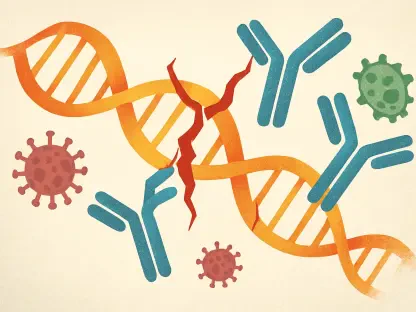Breast cancer remains a leading cause of cancer-related deaths among women in the United States. The prognosis of breast cancer is heavily dependent on the stage at which it is diagnosed, with early detection playing a crucial role in improving survival rates. However, recent research indicates a troubling trend: the rates of metastatic breast cancer, which involves metastasis at the time of diagnosis, are on the rise. This article delves into the findings of a comprehensive study that analyzed data from the Surveillance, Epidemiology, and End Results (SEER) database from 2004 to 2021, highlighting the impact of age, race, and the COVID-19 pandemic on diagnosis and survival outcomes.
Rising Rates of Metastatic Breast Cancer
Increasing Incidence Across Age Groups
The study found a significant increase in the rates of distant-stage or metastatic breast cancer at diagnosis across most demographic groups in the United States between 2004 and 2021. Younger women, particularly those aged between 20 and 39 years, experienced the steepest rise in diagnoses, with an annual percentage change (APC) of 2.91%. For women aged 40 to 74, the rates increased from 2004 to 2010 and again from 2018 to 2021. For women over 75, consistent increases were observed throughout the study period.
The steep rise in metastatic breast cancer among younger women suggests a troubling trend that requires immediate attention. Younger women typically have a lower overall incidence of breast cancer, but when they are diagnosed, the cancer often presents more aggressively and at a later stage. This finding underscores the urgent need for increased awareness, early detection strategies, and targeted screening efforts for younger women to improve their prognosis and survival rates.
Impact on Younger Women
The implications of the rising metastatic breast cancer rates among younger women are particularly concerning for several reasons. This age group typically has better overall health and fewer chronic conditions, making an aggressive breast cancer diagnosis especially devastating. Furthermore, younger women may face unique challenges related to fertility preservation, the psychosocial impact of a cancer diagnosis at a young age, and potential disruptions to their careers and family plans.
The study’s findings underscore the importance of ongoing education and outreach to younger women about breast health and the critical role of regular screenings. By increasing awareness and encouraging early detection strategies, healthcare providers can help mitigate the adverse outcomes associated with late-stage diagnoses in this population. The focus should also be on addressing misconceptions that breast cancer is solely an older woman’s disease and highlighting the importance of vigilance and early detection in all age groups.
Racial and Ethnic Disparities
Higher Incidence Among Black Women
The research highlighted pronounced racial and ethnic disparities in metastatic breast cancer rates. Black women had a 55% higher incidence compared to White women, contributing to higher mortality in this group. This disparity is a significant concern, as it points to systemic issues in healthcare access and quality that disproportionately affect Black women.
The higher incidence of metastatic breast cancer among Black women speaks to broader systemic inequalities in healthcare access, quality, and socioeconomic conditions. These women are more likely to face barriers such as inadequate health insurance, limited access to healthcare facilities, and lower likelihood of receiving timely screenings and follow-up care. Moreover, the stress and challenges posed by socioeconomic disparities can negatively impact their overall health, contributing to poorer outcomes.
Trends Among Other Minority Groups
All minority groups demonstrated rising trends in metastatic breast cancer rates, with significant increases observed particularly among Asian and Hispanic women. Although Native American women showed an upward trend in metastatic breast cancer incidence before 2020, data limitations precluded detailed analysis for this group during the pandemic years. These findings highlight the need for targeted interventions to address the unique challenges faced by different racial and ethnic groups.
The rising trends among other minority groups underscore that racial and ethnic disparities in breast cancer outcomes are not confined to Black women alone. Asian and Hispanic women also face significant increases in metastatic diagnoses, suggesting that factors such as cultural barriers, language differences, and potential biases in the healthcare system might be contributing to delayed diagnoses and treatment. Addressing these issues requires culturally sensitive healthcare approaches, increased community outreach, and policies aimed at equalizing access to high-quality healthcare for all racial and ethnic groups.
Impact of the COVID-19 Pandemic
Disruptions in Healthcare Access
The COVID-19 pandemic temporarily reduced reported incidence rates, likely due to disruptions in healthcare access and delayed diagnoses. This effect was most pronounced in older women and those from racial and ethnic minorities. The pandemic exacerbated existing disparities in healthcare access, making it even more challenging for vulnerable populations to receive timely and effective breast cancer care.
During the height of the pandemic, many healthcare facilities postponed non-urgent medical appointments and screenings, resulting in a significant backlog. This delay contributed to a temporary decrease in reported breast cancer cases, as routine mammograms and other diagnostic procedures were deferred. Vulnerable populations, particularly racial and ethnic minorities, faced even more substantial barriers as they were disproportionately affected by COVID-19 and its associated economic and healthcare disruptions.
Resumption of Upward Trends
Despite the temporary reduction in reported incidence rates during the pandemic, the upward trend in metastatic breast cancer rates resumed in 2021. This underscores the ongoing challenges in breast cancer care and the need for sustained efforts to ensure that all women have access to early detection and treatment services, regardless of their background or circumstances.
The resumption of these upward trends post-pandemic emphasizes the importance of addressing the backlogs in screenings and ensuring that all women have access to timely and effective breast cancer care moving forward. It also highlights the resilience of healthcare systems and the need to build more robust infrastructures that can withstand future public health emergencies. Ensuring equitable access to lifesaving cancer screenings and treatments should remain a top priority, with particular attention to reaching those most affected by healthcare disparities.
Addressing the Challenges
Enhanced Screening Programs
To combat the rising rates of metastatic breast cancer, the researchers recommend targeted efforts to increase mammography screening rates, particularly among younger women and racial minorities. Early detection through regular screenings can significantly improve survival rates and reduce the incidence of advanced-stage disease.
Addressing Socioeconomic Disparities
Policies aimed at reducing socioeconomic disparities can play a significant role in improving access to healthcare resources, including regular cancer screenings. By addressing the root causes of these disparities, such as income inequality and lack of insurance coverage, we can work towards more equitable healthcare outcomes for all women.
Uniform Screening Guidelines
Establishing and promoting consistent screening guidelines across different demographic groups can ensure equitable access to early detection services. Uniform guidelines can help eliminate confusion and ensure that all women receive the same standard of care, regardless of their age, race, or socioeconomic status.
Expanding Telehealth Services
The expansion of telehealth services for consultations and follow-ups could mitigate some of the access issues highlighted during the pandemic. Telehealth can provide a convenient and accessible option for women who may face barriers to in-person healthcare visits, such as transportation challenges or geographic isolation.
Public Health Campaigns
Increasing awareness through public health campaigns about the importance of regular screenings and early detection could improve outcomes, especially in underserved communities. These campaigns can help educate women about the signs and symptoms of breast cancer and the importance of seeking timely medical care.
Continued Research and Data Collection
Ongoing research and comprehensive data collection are essential to monitor trends, understand the underlying causes of disparities, and develop targeted interventions. By continuing to study the factors contributing to rising metastatic breast cancer rates, we can identify effective strategies to address this pressing public health crisis.
Addressing the Challenges
Enhanced Screening Programs
One of the most critical steps to mitigating the rising rates of metastatic breast cancer is the implementation and expansion of enhanced screening programs. These targeted initiatives should focus on increasing mammography screening rates, particularly among younger women and racial minorities. Given that early detection significantly improves survival rates and reduces the incidence of advanced-stage disease, these programs are essential in providing timely interventions.
Enhanced screening programs can also deploy mobile mammography units to reach underserved areas, ensuring that women in rural and economically disadvantaged regions have access to breast cancer screening services. Additionally, providing educational resources tailored to diverse communities can help dispel myths and increase the uptake of screenings. These efforts must be supported by policies that make screening affordable or free for all women, regardless of their financial situation.
Addressing Socioeconomic Disparities
Addressing the root causes of socioeconomic disparities is another vital component in improving access to healthcare resources, including cancer screenings. Policies aimed at reducing income inequality, improving health insurance coverage, and ensuring that all women have access to quality healthcare are essential. By addressing these fundamental issues, we can work towards more equitable healthcare outcomes for all women, not just those who can afford it.
Community-based interventions and programs can also play a significant role in bridging the gap. Providing funding for local health clinics that offer breast cancer screening and follow-up care at low or no cost can make a significant difference. Furthermore, training healthcare providers to recognize and address the unique needs of women from diverse socioeconomic backgrounds can ensure that all patients receive respectful and comprehensive care.
Uniform Screening Guidelines
Establishing and promoting consistent screening guidelines across different demographic groups can ensure equitable access to early detection services. Standardizing these guidelines can help eliminate confusion and ensure that all women receive the same standard of care, regardless of their age, race, or socioeconomic status. Uniform guidelines can provide clear recommendations on the appropriate age to begin screenings and the frequency at which they should occur.
Healthcare organizations and policymakers should collaborate to develop and disseminate these uniform guidelines widely. Including community leaders and advocates in the process can enhance the legitimacy and acceptance of these guidelines within various communities. Ensuring that screening services are covered by all insurance plans, including Medicaid and Medicare, is essential for facilitating adherence to these guidelines across the population.
Expanding Telehealth Services
The expansion of telehealth services for consultations and follow-ups could mitigate some of the access issues highlighted during the pandemic. Telehealth provides a convenient and accessible option for women who face barriers to in-person healthcare visits, such as transportation challenges or geographic isolation. By offering virtual consultations, healthcare providers can maintain continuity of care and ensure timely follow-ups for their patients.
Telehealth can also facilitate second opinions and consultations with specialists, particularly for women in remote areas. By reducing the need for travel, telehealth can help bridge the gap for those who live far from healthcare facilities. To fully realize the potential of telehealth, it is crucial to invest in technology infrastructure and ensure that all patients have access to reliable internet services and the necessary devices to participate in virtual care.
Public Health Campaigns
Increasing awareness through public health campaigns about the importance of regular screenings and early detection could improve outcomes, especially in underserved communities. These campaigns should focus on educating women about the signs and symptoms of breast cancer, the importance of seeking timely medical care, and the benefits of early detection. Additionally, addressing cultural and linguistic barriers is key to ensuring that these messages reach a broad audience.
Effective public health campaigns should collaborate with community-based organizations, faith leaders, and local influencers to disseminate information and encourage women to prioritize their health. Providing resources and information in multiple languages and culturally relevant formats can help engage diverse populations. By fostering a supportive and informed community environment, public health campaigns can play a crucial role in reducing the incidence of metastatic breast cancer through early detection.
Continued Research and Data Collection
Ongoing research and comprehensive data collection are essential to monitor trends, understand the underlying causes of disparities, and develop targeted interventions. By continuing to study the factors contributing to rising metastatic breast cancer rates, we can identify effective strategies to address this pressing public health crisis. Research should focus on identifying the most significant barriers to early detection and exploring innovative approaches to overcome them.
In addition to traditional research methods, leveraging big data and artificial intelligence can provide deeper insights into trends and patterns in breast cancer diagnoses. By analyzing large datasets, researchers can identify previously unrecognized factors that contribute to disparities in breast cancer outcomes. Continuous data collection also enables the evaluation of existing interventions and policies, ensuring that resources are allocated to the most effective strategies in combating metastatic breast cancer.
Final Thoughts
Breast cancer remains one of the leading causes of cancer-related deaths among women in the United States. The outlook for those diagnosed with breast cancer largely depends on the stage at which it is discovered. Early detection is key to significantly improving survival rates. However, recent studies have highlighted a concerning trend: an increase in the rates of metastatic breast cancer, where the cancer has already spread at the time of diagnosis.
This article explores the findings of an extensive study that reviewed data from the Surveillance, Epidemiology, and End Results (SEER) database, covering years from 2004 to 2021. The study shed light on how factors like age, race, and the COVID-19 pandemic have influenced diagnosis and survival outcomes. The data suggest that certain age groups and racial demographics are more prone to later-stage diagnoses, which can complicate treatment and reduce survival chances.
Additionally, the COVID-19 pandemic has posed significant challenges in cancer detection and treatment, potentially delaying diagnoses and thereby worsening prognoses. As a result, widespread awareness and targeted interventions are crucial for early detection and reducing the mortality associated with breast cancer. The findings from the SEER database underscore the importance of regular screenings and timely medical consultations, highlighting an urgent need for improved healthcare strategies to tackle this rising trend in metastatic breast cancer.









